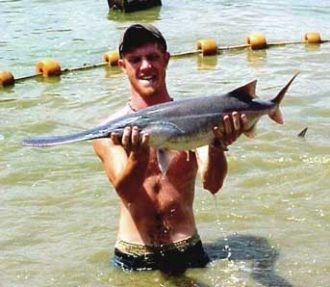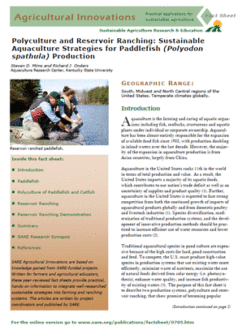
Paddlefish, closely related to sturgeons, are filter feeders throughout most of their lives and the only members of the family Polyodontidae on the continent (4). Paddlefish have a mostly cartilaginous skeleton guaranteeing no bones in the meat. Paddlefish grow rapidly, up to 0.75 pounds/month, and can be easily harvested by seining or gill netting. Paddlefish reproduction can be induced with hormones to propagate; and fingerlings can be raised intensively up to stocker size of more than 12 inches in the same season. Mature female fish (about 20 to 70 pounds) can produce about 15 percent of their body weight in roe (3 to 10 pounds). However, there are some disadvantages to paddlefish and their production. They have poor tolerance for low dissolved oxygen (<2 ppm), and show handling stress when water temperatures are higher than 70° F. Artificial propagation and fingerling production are complex procedures and fingerlings are vulnerable to bird predation (5).
Paddlefish have long been an alternative to sturgeon as a source of meat and caviar. Formerly abundant in the Mississippi River basin and adjacent Gulf Coast drainage, natural populations of paddlefish were commercially harvested for their high-valued, boneless meat and roe sold as caviar. Continued loss and alteration of natural spawning habitat, organochlorine (i.e. chlordane and PCB) contaminants, and overexploitation by commercial fishing are believed to be the main reasons for declining populations.
The listing of sturgeon and paddlefish species by the United Nations Convention on International Trade in Endangered Species (CITES) greatly restricts the importation of sturgeon products from the Caspian Sea area, the major source for the world's supply of caviar and sturgeon meat products. As a result, there is an increasing gap between the demand and supply of those products. In some markets, wild-caught paddlefish have been substituted for sturgeon because of their similarity in taste and quality. Producing cultured paddlefish in the United States would help to meet the consumer demand and, at the same time, reduce the pressure on natural paddlefish/sturgeon populations.
Extensive water resources suitable for growing paddlefish exist in the United States, including millions of acres of private and public reservoirs throughout the United States built for flood control management and/or hydroelectric production. Most of those reservoirs are managed exclusively for sport fish. However, if paddlefish were permitted to be stocked at 10 fish/acre in just 2,000 acres/year and with a 75-percent harvest rate, it is predicted that enough meat and caviar per year (after an initial waiting period of at least seven years) could be produced to impact the economy by as much as $7 million a year. Further, with catfish production being the largest segment of U.S. aquaculture, there are over 175,000 acres of existing catfish ponds in the southern region (1) where paddlefish could be raised also.
High feed cost is one of the major factors limiting the income of catfish farmers. However, excess feed and excrement from catfish make these ponds nutrient-rich and abundant with zooplankton. Polyculture of catfish with a filter feeding species such as paddlefish could take advantage of the zooplankton in catfish ponds to increase the fish yield per acre without adding to the feed cost. Though bighead carp, a filter-feeding fish native to China, have been introduced into catfish ponds and have demonstrated yields of 300-500 kg/ha (6), meat from this species is not well accepted by American consumers because it has small bones and a strong fish taste, causing a low market value for this product. However, paddlefish, a native filter feeding species, provides a more valuable meat with no bones, a mild flavor and a firm texture (5).
